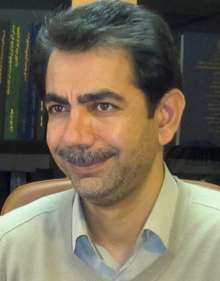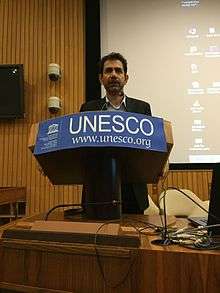Mohammad Ali Sarlak

Mohammad Ali Sarlak (born March 25, 1970, Iran) is an International author and researcher.[1] He is a professor of organizational behavior management at Payame Noor University (PNU), and current president of post graduate center of this university.[2] He is known for introducing new concept of the organization’s face in a multi volume book entitled:The new faces of organizations in the 21st century[3][4][5] and as well as for his role as past president of the Payame Noor University as one of the world's Mega Universities.

Education
Ph.D: Organizational Behavior Management, University of Tehran, 2005.
M.B.A: University of Tehran, 1995.
B.S: Business Administration, University of Tehran, 1993.
Ideas and Concepts
Much of prof. sarlak's works concentrated on Advancing the boundaries of management knowledge. Some of his new ideas and conceptualizations are as follows:
- The organizational Rip currents.[6]
- The Commotion–result Theory .[7] .[8]
- Management by Reaction .[9]
- The organizational Climate Inversion .[10]
- The Behavioral Entropy .[11]
- The organizational Life Expectancy .[12]
Positions
- President of Payame Noor University (PNU) (2014–2015).
- President of Post Graduate Center of Payame Noor University (2007–Present).[2]
- A member of Executive Committee of AAOU (Asian Association of Open Universities) in 2015 .[13]
- A board member of Iranian Academy of Management sciences (2016).[14]
- A member of the Central promotion Committee of the Ministry of Science ,Research and Technology (2015–present).[15]
- A member of the National Committee of UNESCO (2015–present).[16]
- The Establisher of a UNESCO Chair on Environmental Education [17]
- A member of policymaking and scientific council of Iran Inventions Grand Prize[18]
Journals Editor in chief
1. Iranian journal of Management of public organizations [19](2013–present)
2. International Journal of the Academy of Organizational Behavior Management, CANADA[20](2012–2014).
3. International Journal of E-Entrepreneurship and Innovation (IJEEI), IGI, USA[21](2010–2012).
Published Books
1. The New Faces of Organizations in the 21st Century (Volume 1), NAISIT, 2011, CANADA
2. The New Faces of Organizations in the 21st Century (Volume 2), NAISIT, 2011, CANADA
3. The New Faces of Organizations in the 21st Century (Volume 3) , NAISIT, 2011, CANADA
4. The New Faces of Organizations in the 21st Century (Volume 4) , NAISIT, 2012, CANADA
5. The New Faces of Organizations in the 21st Century (Volume 5) , NAISIT, 2012, CANADA
6. E-Banking and Emerging Multidisciplinary Processes, IGI,2011, USA.
7. Barriers of E-Commerce Acceptance in Export, LAMBERT,2011,USA.
8. The Emerging Faces of Organizations in the 21st Century (Volume 1),Knowledge Reference Publisher,2013,IRAN.
9. The Emerging Faces of Organizations in the 21st Century (Volume 2),Knowledge Reference Publisher,2013,IRAN.
10. The Emerging Faces of Organizations in the 21st Century (Volume 3),Knowledge Reference Publisher,2013,IRAN.
11. The Emerging Faces of Organizations in the 21st Century (Volume 4),Knowledge Reference Publisher,2013,IRAN.
12. The organizations in knowledge Era ,Payame Noor Publisher,edition2,2012,IRAN.
13. Advanced Management Information Systems, Payame Noor Publisher, edition2. , 2011,IRAN.
14. Healthy Organization in Practice, Knowledge Reference Publisher,2014,IRAN.
15. E-Government, Knowledge Reference Publisher,2013,IRAN.
16. Managing Organizational trauma, Mir Mah Press,2016,IRAN.
17. Trauma Management from Islam View point., Mir Mah Press,2016,IRAN.
18. The new era of management,(Richard.L.Daft): Translated in Farsi By Dr.Sarlak , Gostareh,Press, 2008,IRAN.
Research Works
He has published over one hundred scientific papers[22] and directed more than 250 master's thesis[23] and doctoral dissertations.[24]
The concept of organization’s face
The concept of organization’s face represents something that identifies and distinguishes the organization from other similar organizations. This concept is based on tow underlying metaphors:
The Organizations as living entity such as humans can be distinguished by face factor from each other. The question is what are the factors that determine an organization’s face? To answer this question, should be attention to pillars of an organization.[25] Every organization has at least five following pillars.[25]
- People
- Goals
- Structure
- Technology
- Environment
With an emphasis on each of the organizational pillars, a specific type of organization’s face is formed.Every organization can demonstrate five general face, simultaneously or separately:
- Humanistic face
- Goal oriented face
- Structure oriented face
- Technology based face
- Environment based face
Each of these faces is divided into more specific faces.
References
- ↑ Google Scholar list of publications by Mohammad Ali Sarlak and related citations
- 1 2 http://www.pnu.ac.ir/portal/Home/Default.aspx?CategoryID=90c596fd-f593-4b7b-a3a3-d4f54fa0f29f
- ↑ https://www.amazon.com/s/ref=dp_byline_sr_book_1?ie=UTF8&text=Mohammad+A.+Sarlak&search-alias=books&field-author=Mohammad+A.+Sarlak&sort=relevancerank
- ↑ Sarlak, Mohammad. A. (2011). The New Faces of Organizations in the 21st Century (Volumes:1,2,3). Canada: NAISIT Publishers.
- ↑ Sarlak, Mohammad. A. (2012). The New Faces of Organizations in the 21st Century (Volumes:4,5). Canada: NAISIT Publishers.
- ↑ https://jipa.ut.ac.ir/article_62176_en.html
- ↑ http://journals.pnu.ac.ir/article_3622_4.html
- ↑ https://www.omicsonline.org/open-access/identification-of-the-strategies-of-organizational-brawl-management-2162-6359-1000427.php?aid=89657
- ↑ http://upna.ir/?p=51303
- ↑ http://modamnet.com/product/%D9%88%D8%A7%D8%B1%D9%88%D9%86%DA%AF%DB%8C-%D8%AC%D9%88-%D8%B3%D8%A7%D8%B2%D9%85%D8%A7%D9%86%DB%8C/
- ↑ http://www.iran-academy.org/%D9%85%D8%B7%D8%A7%D9%84%D8%A8-%D8%A2%D9%85%D9%88%D8%B2%D8%B4%DB%8C/838-%DA%86%D8%B1%D8%A7-%D8%B1%D9%81%D8%AA%D8%A7%D8%B1-%DA%A9%D8%A7%D8%B1%DA%A9%D9%86%D8%A7%D9%86-%D8%B3%D8%A7%D8%B2%D9%85%D8%A7%D9%86-%D8%AA%D8%BA%DB%8C%DB%8C%D8%B1-%D9%85%DB%8C-%DA%A9%D9%86%D8%AF%D8%9F.html
- ↑ http://modamnet.com/product/%D8%A7%D9%85%DB%8C%D8%AF-%D8%A8%D9%87-%D8%B2%D9%86%D8%AF%DA%AF%DB%8C-%D8%B3%D8%A7%D8%B2%D9%85%D8%A7%D9%86%DB%8C/
- ↑ http://aaou.ouhk.edu.hk/about.htm
- ↑ http://www.iams.ir/fa/NewsDetails.aspx?NewsId=1038
- ↑ http://www.irna.ir/fa/News/81610749/
- ↑ http://www.mehrnews.com/news/2896487
- ↑ http://iranunesco.ir/project/en/news/58/
- ↑ http://iigp.ir/en/ScientificBoard.aspx
- ↑ http://ipom.journals.pnu.ac.ir
- ↑ http://www.iaobm.ca/journal
- ↑ https://www.amazon.com/International-Journal-E-Entrepreneurship-Innovation-Mohammad/dp/1616929782
- ↑ https://scholar.google.com/scholar?hl=en&q=mohammad+ali+sarlak&btnG=&as_sdt=1%2C5&as_sdtp=
- ↑ http://www.pnu.ac.ir/portal/File/ShowFile.aspx?ID=c03b9522-22ea-4415-b7a1-7723a2951306
- ↑ http://www.pnu.ac.ir/portal/File/ShowFile.aspx?ID=807dafb9-c5bb-4619-95f1-2481a4ea89aa
- 1 2 3 Scott, W. Richard. (1998). Organizations: Rational, Natural, and Open Systems, 4th edn . Upper Saddle River, NJ: Prentice-Hall.
- ↑ Morgan, Gareth. (2006). Images of Organization. Newbury Park. CA: Sage Publications.